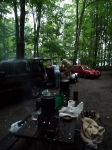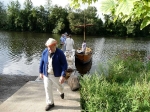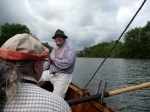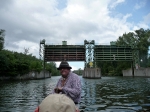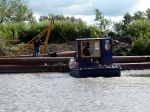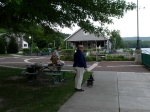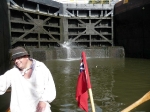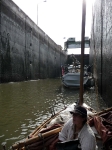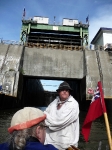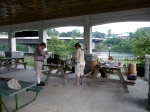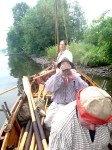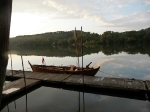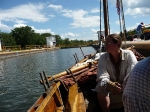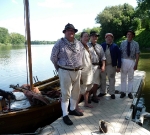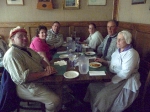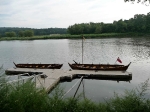Also known as ‘The Big Row, 2011’
All photos were taken by Bill Manthey and is copyright to him. Text is by myself, David Manthey.
Sunday, 21 August 2011 – Delta Lake State Park, Rome, NY
Kevin and I met at the Farm to start off this year’s Big Row. We hooked up the flatbed trailer with the Bobbie G on it, emptied the boat of unneeded items, and placed a few items in the boat for transport. This year is fairly simple – we are in our home waters and are returning to the Farm as part of the row. We are only taking one boat, as I only have four confirmed rowers for the whole trip, plus Mary for Friday.
We drove out to Rome, stopping along the way for a few supplies. We arrived at Delta Lake State Park around 6 p.m., and Bill and Reb arrived shortly after us. Delta Lake is a man-made reservoir at the head of the Mohawk River. It is a scenic spot, but it had rained heavily there earlier in the day, and the ground was sodden.
We set up our tents, ate a dinner of Rolf’s sausage, discussed the trip, organized a few things, and, somewhat surprisingly, didn’t stay up too late.
Monday, 22 August 2011 – Lock 19, Schuyler, NY
We got up fairly early, cooked a quick breakfast of sausage patties and scrambled eggs, struck camp, and made our way the half dozen miles to the Muck Road boat launch. The Muck Road boat launch is where we had put the boats in for the Big Row in 2006 on our way to Oswego. This year we are taking just one boat and going east instead of west (though both years were downstream, as Rome is the heighth of land).
When we first arrived at the boat launch, we were the only people present. We launched the Bobbie G, tied it to the dock, rigged the sail, and started loading the boat. As we worked, a dozen or so people showed up to see us off. They had seen one of the small articles in the newspaper about the trip and came to see what it was about.
As always, the first day seems disorganized as we merge multiple sets of supplies into a single unit. We had everything we needed – water, food, tents, bedding, oars, sailing rig, etc.
Some of the spectators asked good questions. One fellow was from Erie Canal Village and had helped with the old New York State Museum bateau.
We managed to launch just at 9:00, which was my desired departure time. Today is the longest day of the trip, and I was eager to be on our way. The wind was light and mostly westerly, so we had high hopes. A light rain was falling, but not enough to inconvenience anyone.
As soon as we were out of sight of the boat launch, we paused to rearrange some gear. Since a light favorable wind was blowing we hoisted sail. Naturally, the wind seemed to immediately abate, and it would be a short while before the sail provided much power.
The day proved to be a pleasant one. A moderate to light wind provided us with some motive force most of the day. Any time it provided more than 1 1/2 miles per hour of speed, we let it do the work, with Reb on the whisker-boom and myself on the steering oar. At times it gusted to seven or eight miles an hour, moving us along at three or four miles an hour. At times it veered abeam, and we trimmed the braces and sheets accordingly. We were taken aback only rarely, and doused the sail only for brief periods. More often, the wind died for a while, and we proceeded under oars.
Considering the length of the day’s travel, we made quite good time. We covered 21.2 miles (or so) in a little over 8 hours, including the time to lock through Lock 20. This may not seem fast, but we were pleased with the progress.
We passed through Lock 20 around midday, using the VHF radio to call the lock. Some of the people who had seen us launch were waiting at the lock to see how we were doing. A few of them had also stopped along the route to watch us row or sail by. Lock 20 has a beautiful park associated with it, but we just continued without getting out.
When we finally arrived at Lock 19, we had a little bit of consternation on the best place to tie up the bateau for the evening. The upper wall is reinforced with metal, and the fenders didn’t do enough to protect the boat properly. There was a large metal float (perhaps 20 feet by six feet in size) tied to the upper end of the south wall, and we made fast to it. We had to adjust the float’s mooring lines to prevent our bow from being battered against the lock wall. On the far side of the lock there was a low wooden dock, but without any mooring points that we could make use of.
We clambered up the concrete wall from the float and on to the lock wall. This was not a graceful process. We introduced ourselves to the lock tender, and he seemed a bit puzzled to see us. We unloaded the boat and set up camp.
One change that has occurred over the last year or so is the disappearance of public port-a-johns. Knowing that this could be a problem, I had ordered a substitute from Campmor. This was nothing more than a bucket with a toilet seat and lid. The reviewers had advised using two bags as the liner. We had brought an extra tent for just such an eventuality, so, in addition to our sleeping tents, we set up a ‘necessary’ tent. We all agreed: we’ve used worse places.
Kevin made a nice dinner of braised beef with oysters in a brown sauce, plus rice with spinach. We ate it with relish. Historically, we can document a large number of oysters being transported by bateaux up the Mohawk valley. I think most of these were transported in their shells (based on the number of shells found by archeologists), and they were also packed in brine. Since we have been hearing about this archeological research, both Kevin and I had planned meals with oysters. For this trip, we used canned oysters.
While enjoying the pleasant lock grounds for the evening, several spectators stopped by to see us. They had seen the newspaper coverage and wanted to see what we were doing.
Bill attempted to make a fishing pole from a stick and a bit of string. This would be a source of amusement for days.
Total distance today: 21.2 miles.
Tuesday, 23 August 2011 – Rotary Park, Little Falls, NY
We breakfasted on Scotch Eggs, made coffee, and leisurely struck camp. We were under way around 8:40, but only to lock through Lock 19. We exited the lock around 9:10.
This section of the river is pretty much just man-made canal, and, as a consequence, not terribly interesting. The original Mohawk meanders around, now with less water in it than in the 18th century. For the most part, we were glad to be on an easy waterway, though we also partly lamented that it was artificial.
Today we had light, very fluky winds, mostly from astern. Reb fooled with the whisker-boom, and she and I attempted to trim the sail to the best possible advantage. Mostly, however, we rowed. We switched who was steering throughout the day to give a bit of a break to each person (though Reb claims not to like steering, so she didn’t take a turn doing it).
Bill tried to fish a bit, but not in any serious manner. We ‘encouraged’ him with ‘helpful’ advice. In reality, we’d be delighted if he actually tried more seriously and don’t mean to discourage trolling or fly-casting as he sees fit. Perhaps another year he’ll try with better intent.
We passed several weirs or sunken dams used to regulate the water in the canal. After a while we passed a side basin for the Frankfort Marina (which is also where the Mohawk rejoins the canal).
In the morning we had a rum and cookie call. None of the rowers take as much rum as was issued historically (which is for the best – I don’t know how we’d handle 8 or 10 oz a day).
We ate lunch as we travelled; this was bread, cheese, apples, carrots, and sausage. The carrots were especially welcome – a good addition to the menu.
We stopped at the Gems Along the Mohawk building to use the restrooms. While there, we talked with the crew of the tour boat Lil Diamond. They put out around the same time we did. An hour later they passed us on their way back to Gems, and we heard the crewmember narrating the tour mention us.
Once again, the canal split from the river, and we followed the canal. After several miles, we locked through Lock 18 and rejoined the river. The lock tender of Lock 18 asked where we were headed. Today is a comparatively short day. I had originally though to camp at Lock 17, though knew that Moss Island was probably out. There is a town dock of some sort for Little Falls, and the lower lock wall was also an option, but the turbulence from Lock 17 is troubling. Someone asked if we’d stop at the Little Falls Marina. The last time I had been though Little Falls, the only marina-like area was the town dock, and wasn’t all that keen on it. As such, I told the Lock 18 lock tender that I thought to camp at Lock 17; he expressed his opinion that it wasn’t the best choice.
The wind abandoned us, backing a little, and we were left rowing the rest of the day. Even though we had rejoined the river, it is still quite straight in this area.
Just before we got to the section where the canal splits from the river to go to Lock 17, there was the Little Falls Rotary Park. It is a beautiful park – a refurbished warehouse has been turned into a community building with showers and lavatories, a lovely lounge, and a meeting room. There is a small-boat friendly plastic dock, a boat ramp, and grassy areas with shade. In short, it is everything one could wish for in an area to tie up along the river.
We tied up at the dock next to the boat ramp, made sure that we could camp, and then moved to the main dock. There were three other transient vessels present: a nice sailing yacht and two power boats. The harbor master was a volunteer (a paid employee would come on duty shortly thereafter), and had read about us in the paper.
We gradually unloaded the boat and set up camp. The fee for docking was incredibly cheap – $12, since we weren’t using the dock utilities (it would have only been twice that if we needed power and water for the boat).
I cooked dinner, starting with an appetizer of oysters dredged in flour with mace and lemon zest and fried in olive oil. This was followed by a simple chicken, barley, and pea soup.
We talked with all sorts of people, some of whom stopped by specifically to see us. Kenny and his wife stopped by to say hello, as did Dave W. Dave said he might join us tomorrow, which would be great.
Eventually we retired to bed.
15.1 miles today. 36.3 total miles.
Later, I learned that Harvey, Mary, and Ann had met for the usual Tuesday night rowing and had gone out in the DeSager.
Wednesday, 24 August 2011 – Canajoharie, NY
We had sausages and scrambled eggs for breakfast and broke camp leisurely. As we were doing so, Dave W. showed up for the day. His daughter dropped him off. We were delighted to have him – he has been on previous rowing trips with us and is a good rower and a good companion.
We said a fond farewell to Little Falls. It was nice campsite and a friendly town.
The wind was the predominant feature today. It blew easterly all day, mostly ranging between 5 and 10 miles per hour, but with frequent sustained gusts of 10 to 20. We were very glad to have an extra rower for the day, as the wind was unrelenting. Furthermore, the forecast had claimed that the wind would veer about in the midday; this proved to be false.
The first three-quarters of a mile was the canal above Little Falls on the south side of Moss Island. We passed the old town dock, now looking disused, though with a nice grass sward along it. We passed a small rocky island that isn’t named on my charts. For some reason, I believe it to be called Goat Island, but I’m not sure why.
Just around a bend from the island was the top of Lock 17. We radioed ahead and ended up sharing the lock with Alizé, one of the boats that had been at Little Falls overnight.
Lock 17, as always, is a treat. It is the highest lock on the Erie Canal. At the time it was built, it was the highest in the world, but it has been long surpassed by others. It is still very impressive, with a down-stream guillotine-style gate rather than the swing gates on all of the other locks. Even though some of the other locks are nearly as deep, the 40.5 feet of Lock 17 feels substantially greater than the 35 feet of some of the locks in the Flight of Five near Waterford.
The north wall of the lock spits quite a bit of water, and regulations require that vessels tie along the south wall. The trip down is smooth, just like other locks, but much longer and danker due to the depth. The guillotine gate feels slower than the swing gates, and feels ‘tight’ when exiting. We rowed out into the river, delighted with the early-20th century engineering.
A few miles below Lock 17 we passed Herkimer Home. This was been a popular spot for bateaux to stop in the 18th century. Due to some logistics issues, we didn’t stop at it on this trip; we rowed by the dock and continued on our way.
A few more miles brought us to another canal section. A dredger was working near the guard gates. This is something like the fifth dredger we’ve seen on the trip. The Canal Corporation appears to be very busy with maintenance.
A long pull along the straight lines of the canal felt even longer with the wind. We had good views of Interstate 90, and we jokingly feared that the sight of an unusual boat would cause an accident. A few vehicles slowed, and several trucks honked in greeting, but we didn’t disrupt traffic much at all.
We locked through Lock 16 and rejoined the river, now somewhat larger with the addition of East Canada Creek. The river turned south-southeast, and the wind also came from the south. We couldn’t get out of it, so we just kept rowing. We felt that any pause for any reason would lose way, and we didn’t want that. Even when someone took a break, someone else always pulled at an oar.
After what seemed an immense effort, we stopped in the lee of Abeel Island. Here Bill contrived to lose his make-shift fishing pole, which was just as well, as he had received nothing but grief over it and the quality of his tackle.
We rowed down the comparative shallows of the western side of Abeel Island, then back out into the wind to get to Lock 15. Fort Plain and Otsquago Creek followed, plus more views of the throughway, and, of course, more wind.
The river turned back to the east. The wind wasn’t quite as bad, though still present. We were tired and the evening seemed to be approaching when we locked through Lock 14. It bears a new sign prohibiting mooring due to some restriction based on a nearby railroad – silly, but it would be a noisy campsite anyway.
Just below Lock 14 we pulled up to the Canajoharie wall. This is a pleasant town park with good water, a picnic pavilion, and some swing benches. The dock was commodious. We tied up near Alizé, happy to be done for the day. A short time later one of the Mallory Line packet boats arrived (these are rental boats that look quite nice).
Dave’s wife Sue Ann showed up, and, after a bit went away and reappeared with a dulcimer and a recorder. She played period music while we set up camp and made dinner. Sue Ann also brought us a lemon-nut loaf which we quite enjoyed the following day.
Kevin made a nice dinner; it was some sort of pork stew that we ate with great relish. It was accompanied by rice with spinach and zucchini.
One lack in the park was any sort of port-a-john, so, for the second time, we deployed the extra tent and our sufficient-but-undesirable solution.
Sue Ann and Dave departed. It was such a pleasure to have Dave for the row and Sue Ann for the dinner music. It is wonderful to have friends.
We went to bed tolerably late, as we hadn’t arrived until around 6 p.m. We were very much ready for sleep.
19.4 miles today. 55.7 total miles.
Thursday, 25 August 2011 – Schoharie Crossing, NY
Sometime around 4 a.m. it started raining. A storm front moved through with lightning on all sides of us (but not right where we were). Being tired from yesterday’s wind, we were slow to get up, and the rain didn’t encourage us.
We lugged the braziers, cook gear, and breakfast items to the picnic pavilion. I made a breakfast of salt beef hash. This included salt beef, a little bit of Rolf’s bacon to grease the pan, a small loaf of bread crumbled into the pan, and some onion. It came out pretty well, I thought. More importantly, it gave us all a very necessary salt supplement. Modern diets eschew salt, but if one is active, it is vital to prevent muscle cramps and alleviate fatigue.
The rain had mostly abated, and we slowly struck camp. We managed to get underway just around 9 a.m., which we thought was an excellent start considering how tired we had been.
The day was overcast, with intermittent light rain. There was a very light east wind. I’m sure it was a mild hindrance, but nothing compared with yesterday. I had checked a weather report which claimed 6 knot westerlies all day – we never saw any westerlies, only light easterlies. Weather reports are truly awful when it comes to wind predictions.
The river looks more natural here, not being directly a canal cut (though I’m sure there has been plenty of dredging and other improvements to it). We rowed comfortably, frequently seeing the throughway.
Two and a half hours of steady rowing brought us to Lock 13. This was comparatively uneventful. We talked less than previous days, though we did attempt a few songs. Kevin knows more lyrics than the rest of us combined. None of us will win awards for singing, though.
In the early afternoon we passed Fonda and Fultonville. The part of Fultonville visible from the river seems to all be truck stops, motels, and restaurants geared to travellers. We also admired the old crane at the canal service area in Fonda.
Today would be the second longest day, just a little longer than yesterday. The wind, being lighter, made it seem substantially shorter than Wednesday, even without Dave on an oar.
Schoharie Creek empties into the Mohawk River just above Lock 12. I had forgotten the exact topography of the area. We locked through, knowing we just had a few more miles to go for our campsite. We were eager to get there, partly because we were, once again, tired, but also because some dark clouds were coming in from the west.
Despite the storm clouds blowing in from the west, we still did not have any appreciable wind. The sail would have been an impediment. We went by Upper Pepper Island. I saw the Yankee Hill dock just at the point of a modest bend in the river.
As we passed Lower Pepper Island the dock seemed to recede even as we neared it. This was a trick of the light; the gathering clouds added gloom faster than the reducing distance added clarity.
A publication has stated that we would be at Yankee Hill between 5 and 6 p.m. I had originally said something much, much more vague – wind and strength not being neatly predictable. Yet, here we were, arriving right around 5:30.
A dozen people were awaiting us, some on the dock and some on the grassy area around the old locks. We tied up to the dock and started talking to the visitors, answering questions, and explaining our trip.
Some of the visitors asked good questions. Some seemed to expect something larger than the bateau, or perhaps were expecting us to do something more than set up camp. We answered the questions that were asked and gradually unloaded the boat.
The Yankee Hill area is an old Erie Canal lock, plus a building that is representative of an old canal store. The building has restrooms. All around this is a lovely stretch of grass, not especially level, but quite well maintained.
A nice site, with only one significant defect – the ramp leading to the dock is far too steep. The dock and the ramp are wooden, and, with the recent rain, the ramp was very slippery. It is steep enough that this is a problem; each of us fell in varying degrees while trying to go to and from the dock. Reb ended up hauling everything out of the boat and passing it up the ramp.
My wife, Heather, and my dog, Monty, showed up to see us at this point. They brought some much desired fruit and vegetables. They didn’t stay long, as Heather had to be somewhere to meet someone. It was good to see them.
Reb made fried zucchini slices as an appetizer. I made a dinner of boiled ham and potatoes. It was simple, but we devoured almost all of it. We saved the trivial amount of leftovers for breakfast, then snacked on grapes and watermelon.
Ah, bed.
19.7 miles today. 75.4 total miles.
Friday, 26 August 2011 – Mabee Farm, Rotterdam Junction, NY
A lazy, slow morning.
Rick arrived and joined us. Originally Mary was going to join us for Friday, but she was called away on pressing family business. She had asked Rick to bring us some lunch supplies (not necessary, but not refused), and Rick, rather than just do that, managed to get the day off and join us for the row.
We breakfasted on bacon, three mouthfuls of ham and potatoes, and scrambled eggs. We were hungry from the previous days of rowing, and ate a prodigious amount of everything.
We slowly packed up and were off and rowing a little after 9 a.m.
Today we had light westerly winds. The sail went up and down as needed, with Reb fussing with the whisker-boom. At one point Kevin was steering and I was rowing when the wind picked up. It was the first time on the trip that I had essentially nothing I needed to do except sit in the boat. A most relaxing feeling.
We passed Amsterdam, talked with some boaters along the way, and generally enjoyed the wind-assisted rowing. After days of effort, the reduced labor was most welcome. Additionally, you could tell we were all eager to be back at the Mabee Farm – we rowed with more vigor and took fewer breaks.
We locked though Lock 10 right around noon. We barely slowed between Lock 10 and Lock 9. Normally we would have eaten lunch at this point, but we were all keen on “being there”, and just had a quick snack instead.
The river is delightful along this stretch; not too built up and not too artificial. There was some work being done at either end of the railroad bridge in Pattersonville. After we passed that we could see the houses on the south bank that we sometimes see on our evening rows; we were nearly home.
Lock 9 is part of our familiar routine, and we were happy to be back in our home navigation pool. A short distance later we could see the Mabee Farm dock. I blew the horn to announce our arrival. Heather and Monty met us at the dock as we came in, with Katie just behind them.
We tied up to our home dock having completed this year’s Big Row.
13.1 miles today. 88.5 total miles.
We sent Heather, Katie, Reb, and Kevin off to get the vehicles we had left in Rome. Bill and I unloaded the boat and set up camp. By the time the others got back, we had all the gear up from the boat and behind the farm house. All of the tents were up.
We all went out to our usual after-rowing restaurant, Pinhead Susan’s in Schenectady.
We returned to camp and went to bed.
Saturday, 27 August 2011
The Mabee Farm was holding a craft fair today. It isn’t a reenactment, and the crafts aren’t specifically related to our time-period of interest. Still, it is our home, and it was good to end a Big Row at the farm.
Katie made a delicious breakfast of French toast.
We sat around and did minor rope work and other maintenance.
We took a few visitors out for a short row, but otherwise didn’t go our in the boats. We talked to a lot of visitors, giving them the historical background on the bateaux and the recent details of the Big Row.
We were warned extensively about an incoming hurricane.
After lunch, we gradually broke camp and each went our separate way. A good trip.
